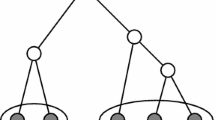Abstract
Many social animals live in stable groups, and it has been argued that kinship plays a major role in their group formation process. In this study we present the mathematical analysis of a recent model which uses kinship as a main factor to explain observed group patterns in a finite sample of individuals. We describe the average number of groups and the probability distribution of group sizes predicted by this model. Our method is based on the study of recursive equations underlying these quantities. We obtain asymptotic equivalents for probability distributions and moments as the sample size increases, and we exhibit power-law behaviours. Computer simulations are also utilized to measure the extent to which the asymptotic approximation can be applied with confidence.
Similar content being viewed by others
References
Archie EA, Moss CJ, Alberts SC (2006) The ties that bind: genetic relatedness predicts the fission and fusion of social groups in wild african elephants. Proc R Soc B: Biol Sci 273: 513–522
Aldous DJ (1996) Probability distributions on cladograms. Random discrete structures. In: Aldous DJ, Pemantle R (eds) IMA volumes math appl, vol 76. Springer, Heidelberg, pp 1–18
Bonabeau E, Dagorn L, Fréon P (1999) Scaling in animal group size distribution. Proc Natl Academy Sci 96: 4472–4477
Blum MGB, François O (2005a) Minimal clade size and external branch length under the neutral coalescent. Adv Appl Probab 37: 647–662
Blum MGB, François O (2005b) On statistical tests of phylogenetic imbalance: the sackin and other indices revisited. Math Biosci 195: 141–153
Dawkins R (1989) The selfish gene. Oxford University Press, London
Durand E, Blum MGB, François O (2007) Prediction of group patterns in social mammals based on a coalescent model. J Theor Biol 249: 262–270
François O, Mioland C (2007) Gaussian approximation for phylogenetic branch length statistics under stochastic models of biodiversity. Math Biosci 209: 108–123
Gueron S, Levin SA (1995) The dynamics of group formation. Math Biosci 128: 243–264
Giraldeau LA, Caraco T (1993) Genetic relatedness and group size in an aggregation economy. Evol Ecol 7: 429–438
Hamilton IM (2000) Recruiters and joiners: Using optimal skew theory to predict group size and the division of ressources within groups of social foragers. Am Nat 155: 684–695
Hamilton WD (1964) The evolution of social behavior. J Theor Biol 7: 1–52
Hein J, Schierup MH, Wiuf C (2005) Gene genealogies, variation and evolution: a primer in coalescent theory. Oxford University Press, USA
Hwang HK, Neininger R (2002) Phase change of limit laws in the quicksort recurrence under varying toll functions. SIAM J Comput 31(6): 1687–1722
Harding EF (1971) The probabilities of rooted tree-shapes generated by random bifurcation. Adv Appl Prob 3: 44–77
Knuth DE (1973) The art of computer programming. Fundamental algorithms, vol I, 2nd edn. Addison-Wesley, Reading
Kingman JFC (1982) The coalescent. Stoch Proc Appl 13: 235–248
Popovic L (2005) Asymptotic genealogy of a critical branching process. Ann Appl Probab 14: 2120–2148
Rubenstein DI (1978) On predation, competition, and the advantages of group living. Perspect Ethol 3: 205–232
Rosler U (1991) A limit theorem for quicksort. Theor Appl Inform 25: 85–100
Sedgewick R, Flajolet P (1996) An introduction to the analysis of algorithms. Addison-Wesley Longman Publishing Co., Inc., Boston
Takayasu H (1989) Steady-state distribution of generalized aggregation system with injection. Phys Rev Lett 63: 2563–2565
Tavaré S (2004) Ancestral inference in population genetics. In: Picard J (ed) Lectures on probability theory and statistics. Ecole d’Etés de Probabilité de Saint-Flour XXXI, 2001. Lecture notes in mathematics, vol 1837. Springer, New York, pp 1–188
Yokoyama S, Felsenstein J (1978) A model of kin selection for an altruistic trait considered as a quantitative character. Proc Natl Academy Sci 75: 420–422
Yule GU (1924) A mathematical theory of evolution, based on the conclusions of Dr J. C. Willis. Philos Trans R Soc Lon Ser B 213: 21–87
Author information
Authors and Affiliations
Corresponding author
Rights and permissions
About this article
Cite this article
Durand, E., François, O. Probabilistic analysis of a genealogical model of animal group patterns. J. Math. Biol. 60, 451–468 (2010). https://doi.org/10.1007/s00285-009-0270-y
Received:
Revised:
Published:
Issue Date:
DOI: https://doi.org/10.1007/s00285-009-0270-y




